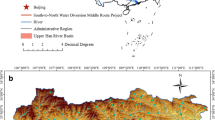Abstract
Short-term water demand forecasting has always been a hot research topic in the field of water distribution systems, and many researchers have developed a wide variety of methods based on different prediction periodicities. However, few studies have paid attention to using ensemble learning methods for short-term water demand forecasting. In this study, an ensemble-learning-based method was developed to forecast short-term water demand. The proposed method consists of two models: an equal-dimension and new-information model and an ensemble learning model. The purpose of the equal-dimension and new-information model is to update data for modelling periodically, while the ensemble learning model is used for water demand forecasting. To evaluate the forecasting performance, the proposed method was applied to a data set obtained from a real-world water distribution system and compared with the single back-propagation neural network (BPNN) model and the seasonal autoregressive integrated moving average (SARIMA) model. The results show that the proposed method improves both the accuracy and stability of water demand prediction. The proposed method has the potential to provide a promising alternative for short-term water demand forecasting.







Similar content being viewed by others
References
Adamowski J, Karapataki C (2010) Comparison of multivariate regression and artificial neural networks for peak urban water-demand forecasting: evaluation of different ANN learning algorithms. J Hydrol Eng 15(10):729–743
Adamowski J, Chan FH, Prasher SO, Ozga-Zielinski B, Sliusarieva A (2012) Comparison of multiple linear and nonlinear regression, autoregressive integrated moving average, artificial neural network, and wavelet artificial neural network methods for urban water demand forecasting in Montreal, Canada. Water Resour Res 48(1):W01528
Banjac G, Vašak M, Baotic M (2015) Adaptable urban water demand prediction system. Water Sci Tech-W Sup 15(5):958–963
Borra S, Ciaccio AD (2002) Improving nonparametric regression methods by bagging and boosting. Comput Stat Data An 38(4):407–420
Bougadis J, Adamowski K, Diduch R (2005) Short-term municipal water demand forecasting. Hydrol Process 19(1):137–148
Campisi-Pinto S, Adamowski J, Oron G (2012) Forecasting urban water demand via wavelet-denoising and neural network models. Case study: city of Syracuse, Italy. Water Resour Manag 26(12):3539–3558
Chen T, Ren J (2009) Bagging for Gaussian process regression. Neurocomputing 72(7):1605–1610
Cheng K (2007) The theory and methods of data preparation : an overview. Statistics Inform Forum 22(6):98–103 (In Chinese)
Donkor E, Mazzuchi T, Soyer R, Roberson J (2014) Urban water demand forecasting: review of methods and models. J Water Res Plan Man 140(2):146–159
Firat M, Yurdusev MA, Turan ME (2009) Evaluation of artificial neural network techniques for municipal water consumption modeling. Water Resour Manag 23(4):617–632
Freund Y, Schapire R (1997) A decision-theoretic generalization of on-line learning and an application to boosting. J Comput Syst Sci 55(1):119–139
Ghiassi M, Zimbra D, Saidane H (2008) Urban water demand forecasting with a dynamic artificial neural network model. J Water Res Plan Man 134(2):138–146
Guo G, Liu S, Wu Y, Li J, Zhou R, Zhu X (2018) Short-term water demand forecast based on deep learning method. J Water Res Plan Man 144(12):04018076
Herrera M, Torgo L, Izquierdo J, Pérez-García R (2010) Predictive models for forecasting hourly urban water demand. J Hydrol 387(1–2):141–150
Jain A, Varshney AK, Joshi UC (2001) Short-term water demand forecast Modelling at IIT Kanpur using artificial neural networks. Water Resour Manag 15(5):299–321
Khwaja A, Zhang X, Anpalagan A (2017) Boosted neural networks for improved short-term electric load forecasting. Electr Power Syst Res 143:431–437
Mathanker SK, Weckler PR, Bowser TJ, Wang N, Maness NO (2011) AdaBoost classifiers for pecan defect classification. Comput Electron Agr 77(1):60–68
Pulido-Calvo I, Gutierrez-Estrada JC (2009) Improved irrigation water demand forecasting using a soft-computing hybrid model. Biosyst Eng 102(2):202–218
Sadeghi BHM (2000) A BP-neural network predictor model for plastic injection molding process. J Mater Process Tech 103(3):411–416
Shao H, Wei H, Deng X, **ng S (2017) Short-term wind speed forecasting using wavelet transformation and AdaBoosting neural networks in Yunnan wind farm. Iet Renew Power Gen 11(4):374–381
Wang R, Xu H, Li B, Feng Y (2018) Research on method of determining hidden layer nodes in BP Neural Network. Comput Technol Develop 28(4):31–35 (In Chinese)
Yang M, Crenshaw J, Augustine B, Mareachen R, Wu Y (2010) AdaBoost-based face detection for embedded systems. Comput Vis Image Und 114(11):1116–1125
Zhao X, Ning B, Liu L, Song G (2014) A prediction model of short-term ionospheric foF2 based on AdaBoost. Adv Space Res 53(3):387–394
Zhou L, Lai K (2017) AdaBoost models for corporate bankruptcy prediction with missing data. Comput Econ 50(1):69–94
Acknowledgments
This work was funded by the Scientific Research Foundation for High-level Talents of Beibu Gulf University (Grant No. 2019KYQD22) and Guangxi Province Education Department (Grant No 2021KY0438) .
Availability of Data and Material
Some or all data and models that support the findings of this study are available from the corresponding author upon reasonable request.
Code Availability
Some or all code that support the findings of this study are available from the corresponding author upon reasonable request.
Funding
This work was funded by the Scientific Research Foundation for High-level Talents of Beibu Gulf University (Grant No. 2019KYQD22) and Guangxi Province Education Department (Grant No 2021KY0438).
Author information
Authors and Affiliations
Contributions
Haidong Huang contributed to the conception of the study and manuscript preparation;
Zhixiong Zhang helped to perform data analyses;
Fengxuan Song helped to write the manuscript.
Corresponding author
Ethics declarations
Conflicts of Interest/Competing Interests
We declare that there is no conflict of interest.
Additional information
Publisher’s Note
Springer Nature remains neutral with regard to jurisdictional claims in published maps and institutional affiliations.
Rights and permissions
About this article
Cite this article
Huang, H., Zhang, Z. & Song, F. An Ensemble-Learning-Based Method for Short-Term Water Demand Forecasting. Water Resour Manage 35, 1757–1773 (2021). https://doi.org/10.1007/s11269-021-02808-4
Received:
Accepted:
Published:
Issue Date:
DOI: https://doi.org/10.1007/s11269-021-02808-4




